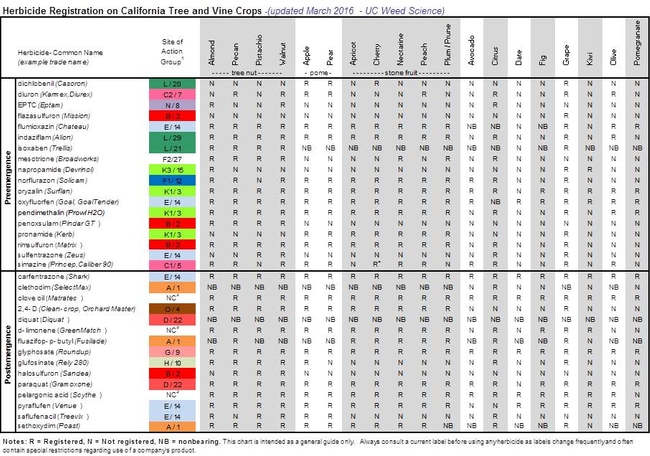March 16, 2016. Editor's note.
I recently was informed of an error in the chart Lynn included in this post from December 2018. While Broadworks (ai = mesotrione) herbicide IS registered in several stonefruit crops, it is NOT currently registered for use in peach. This was entirely my error.
I struck out inclusion of peach in the text below and replaced the chart with an updated version in this post. Remember to always read a current label before applying any pesticide as labels change (or can be misread as was the case when I last updated that chart).
Brad Hanson
In California, that have been 26 confirmed instances of weeds resistant to herbicides. Although the majority of resistances (ALS-inhibitors, ACCase-inhibitors, and thiocarbamates) have developed in rice production systems, some of the most recently reported insensitivities (such as Conyza canadensis (horseweed) and Conyza bonariensis (hairy fleabane)) are to glyphosate and have been reported in orchards and vineyards (via http://weedscience.org/).
One of the recommendations for preventing/managing herbicide resistance advocates diversifying herbicide chemistries to reduce selection pressure; the registration of new products is, therefore, necessary to provide/maintain sufficient diversity with respect to mechanism/mode of action. As a consequence, much of our research in the tree and vine (T&V) weed science lab is devoted to evaluating herbicide performance with respect to weed control efficacy and crop safety.
Broadworks (active ingredient = mesotrione) is a newly registered herbicide (from Syngenta) for use in tree nuts (almonds, pecans, walnuts, pistachios), some stone fruit (nectarines, peaches, plums/prunes), and citrus that have been established for at least 12 months. Mesotrione is a synthetic analog of a naturally occurring herbicidal product derived from the bottlebrush plant (Callistemon citrines). Mesotrione is a Group 27 herbicide as classified by the Weed Science Society of America (WSSA); these herbicides disrupt carotenoid biosynthesis, leading to chlorophyll degradation. Mesotrione has both PRE and POST activity; the use rate is 6 fl oz/A (or 3 oz as a sequential).
Results from a study conducted in 2012 (Figure 1) demonstrates Broadworks residual efficacy against Conyza species. Broadworks alone or in combination with Princep or Matrix was as effective/more effective than Chateau and Pindar GT at suppressing horseweed and hairy fleabane at 50, 80 and 120 days after application. Because Broadworks is mostly effective against broadleaves, a tank-mix partner will be needed for grass control. Although Broadworks can provide sufficient control of Conyza species, as well as other troublesome weeds (such as Polygonum spp., common chickweed (Stellaria media) and Palmer amaranth (Amaranthus palmeri)), not all broadleaves are equally sensitive to mesotrione. In our 2012 trial, spotted spurge (Euphorbia maculata) was not controlled by Broadworks, when used singly at any observation point. These results are very similar to what we have seen in other orchard research trials; Broadworks looks to be a very useful addition to an orchard weed management program (especially if hard-to-control horseweed and fleabane populations are present).
A complete list of currently registered herbicides for tree and vine crops for 2015 can be found in Figure 2, as well as the attached pdf.
Figure 1. Control of grass species (Poa, Lolium spp.), Conyza species, and spotted spurge at 50, 80 and 120 days after application (February 21, 2012). Gramoxone Inteon was applied at a rate of 3 pt/A, Rely was applied at a rate of 3 pt/A. Broadworks was applied at a rate of 6 oz/A, Princep was applied at a rate of 2 qt/A, Matrix was applied at a rate of 4 oz/A, Chateau was applied at a rate of 10 oz/A, Pindar GT was applied at a rate of 3 pt/A.
(CLICK ON PICTURE FOR LARGER IMAGE)
Figure 2. Currently registered herbicides for use in tree and vine crops in California in 2015. Always follow label instructions when making any herbicide application.
(CLICK ON PICTURE FOR LARGER IMAGE)
Attached Files:

